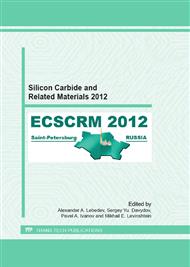p.821
p.825
p.829
p.833
p.837
p.841
p.843
p.847
p.851
Influence of Contact Metallisation on the High Temperature Characteristics of High-κ Dielectrics
Abstract:
In this work SiC-based MIS capacitors have been fabricated with different contact/high-k dielectric combinations and the temperature dependence of the characteristics have been examined in an N2 ambient at temperatures between 323K and 673K. The structures utilise either a Pt or Pd catalytic gate contact and a TiO2 or HfO2 high-k dielectric, all of which are grown on a thin SiO2 layer, thermally grown on the Si face of a 4H SiC epitaxial layer. The MIS capacitors have been studied in an N2 ambient between 323K and 673K and observations show that VFB reduces with increasing temperature. The majority of this variation is caused a reduction in the Dit influencing the structures electrical characteristics, due to a shift in the semiconductors bulk potential, which is due to the lower VTH of SiC-based MOSFETs at high temperatures.
Info:
Periodical:
Pages:
837-840
Citation:
Online since:
January 2013
Keywords:
Price:
Сopyright:
© 2013 Trans Tech Publications Ltd. All Rights Reserved
Share:
Citation:


